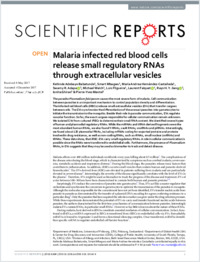Malaria infected red blood cells release small regulatory RNAs through extracellular vesicles
- Babatunde, Kehinde Adebayo Department of Medicine, University of Fribourg, Switzerland
- Mbagwu, Smart Ikechukwu Department of Medicine, University of Fribourg, Switzerland
- Hernández-Castañeda, María Andrea Department of Medicine, University of Fribourg, Switzerland
- Adapa, Swamy R. Department of Global Health (GH) & Center for Drug Discovery and Innovation (CDDI), University of South Florida, Tampa, USA
- Walch, Michael Department of Medicine, University of Fribourg, Switzerland
- Filgueira, Luis Department of Medicine, University of Fribourg, Switzerland
- Falquet, Laurent Department of Medicine, University of Fribourg, Switzerland
- Jiang, Rays H. Y. Department of Global Health (GH) & Center for Drug Discovery and Innovation (CDDI), University of South Florida, Tampa, USA
- Ghiran, Ionita Division of Allergy and Infection, Beth Israel Deaconess Medical Center, Boston, USA
- Mantel, Pierre-Yves Department of Medicine, University of Fribourg, Switzerland
-
17.01.2018
Published in:
- Scientific Reports. - 2018, vol. 8, no. 1, p. 884
English
The parasite Plasmodium falciparum causes the most severe form of malaria. Cell communication between parasites is an important mechanism to control population density and differentiation. The infected red blood cells (iRBCs) release small extracellular vesicles (EVs) that transfer cargoes between cells. The EVs synchronize the differentiation of the asexual parasites into gametocytes to initiate the transmission to the mosquito. Beside their role in parasite communication, EVs regulate vascular function. So far, the exact cargoes responsible for cellular communication remain unknown. We isolated EVs from cultured iRBCs to determine their small RNA content. We identified several types of human and plasmodial regulatory RNAs. While the miRNAs and tRNA-derived fragments were the most abundant human RNAs, we also found Y-RNAs, vault RNAs, snoRNAs and piRNAs. Interestingly, we found about 120 plasmodial RNAs, including mRNAs coding for exported proteins and proteins involved in drug resistance, as well as non-coding RNAs, such as rRNAs, small nuclear (snRNAs) and tRNAs. These data show, that iRBC-EVs carry small regulatory RNAs. A role in cellular communication is possible since the RNAs were transferred to endothelial cells. Furthermore, the presence of Plasmodium RNAs, in EVs suggests that they may be used as biomarker to track and detect disease.
- Faculty
- Faculté des sciences et de médecine
- Department
- Département de Médecine
- Language
-
- English
- Classification
- Biological sciences
- License
- License undefined
- Identifiers
-
- RERO DOC 306880
- DOI 10.1038/s41598-018-19149-9
- Persistent URL
- https://folia.unifr.ch/unifr/documents/306368
Statistics
Document views: 55
File downloads:
- man_mir.pdf: 126
